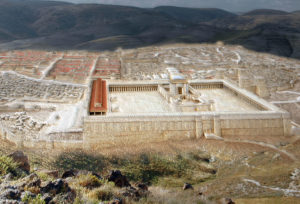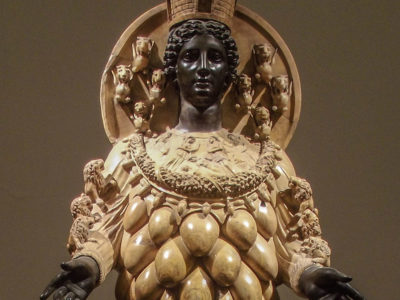IT’S THE FIRST QUESTION anyone would ask after seeing a picture of Artemis, the goddess of Ephesus, one of the four largest cities in the Roman Empire.
What are those bumps sticking out in front?
Here’s the answer: Only the dead know.
I have heard many guesses over the years.
“Eggs” was popular for a while. The theory was that eggs symbolized her fertility – and her ability to produce stuff. Artemis, also known by her Roman name of Diana, was portrayed as the virgin goddess who helped women through childbirth – as though a virgin would know what childbirth is like.
“Breasts” was another popular guess, for the same reason. It symbolized fertility.
One scholar explains why many Bible experts don’t like that guess.
The scholar is James R. Edwards, a theology prof from Whitworth University in Spokane, Washington. He wrote an article about Ephesus for the current issue of Biblical Archaeology Review: “Archaeology gives new reality to Paul’s Ephesus riot,” July/August 2016.
Edwards said,
“Ancients knew well enough how to sculpt the female torso. No sculptor chiseled two dozen egg-shaped objects on the chest of a statue and expected them to be taken for female breasts.”
Makes sense to me.
What does Edwards say the protuberances are?
“Bulls’ testicles.”
At this point, I’m thinking I should copy, paste, and lightly edit the note Edwards wrote to explain why he rejected the idea that the bumps were breasts.
My revision:
“Ancients knew well enough how to sculpt the figure of a bull. No sculptor chiseled two dozen egg-shaped objects on the chest of the lady statue and expected them to be taken for bull balls.”
That said, Edwards does seem to make a reasonable case – at least as reasonable as anyone else made for their guesses:
“Artemis…was honored and served by self-gelded priests whose castration represented the ultimate subservience of masculinity to the divine feminine. A prominent symbol of virility in the ancient world was the bull.”
I’m not sure how much value there is in making guesses about stuff like this. But I do think it’s helpful to learn about the culture in which Paul ministered and in which the early church was born.
It’s especially interesting to me right now because I’m working on an easy-reading paraphrase of the book of Acts. It should be ready soon for release in the Casual English Bible.
After thinking about what Edwards wrote in his article, I find myself wondering again about why Paul told Timothy that women in the Ephesus church shouldn’t talk during worship services (1 Timothy 2:12). Could it be because people in this town that worshiped female dominance, at least in the form of Artemis, were used to seeing women run the program? And because of that, women in the church talked too much?
I don’t know. We’re back to guessing, aren’t we?
Blog subscribers who win books this week
- Rose Riley
- Preston Cave
I give away free books every week to randomly selected subscribers to my free blog or my quarterly newsletter.
Winners now get to choose from a stack of titles, including my two most recent: A Visual Walk Through Genesis and The One-Stop History of the Bible.
Note to the two winners: send me an email and I’ll give you the full list of books from which you can choose.
The deal’s good for a month, or for as long as I have giveaway books available.


Leave a Reply